- NEW DVD Series – Stone Setting with Bezels
- Tube Set Charm by Kim St. Jean
- Prong Basket Pendant by Kim St. Jean
- NEW DVD Series – Stone Setting with Cold Connections
- New DVD Series – Stone Setting with Wire
- NEW DVD Series: Introduction to Stone Setting by Kim St. Jean
- Featured Tool: Bracelet Bending Plier
- NEW Dvd by Eva Sherman
- Fun, Fast Fold Forming DVD Series
- Double Band Ear Cuff from Alex Simkin
Gem Profile Dec. 28: Wishful Turquoise
by Layna Palmer, Wire-Sculpture.com

Turquoise, Part 3
Shop Turquoise on Wire-Sculpture
We’ve reached the end of our series on Turquoise – it’s time to find out what types of "turquoise" are out there besides the natural Turquoise.
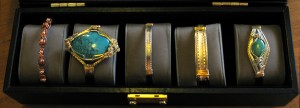
Merry Pringle wrapped this collection of wire bangle bracelets, including 2 turquoise cabochon bracelets. (click to view larger)
Reconstituted Turquoise
Reconstituted turquoise is another type of turquoise on the market today and has a lot of meanings. Reconstituted and block turquoise are essentially the same thing. Very soft (chalk) turquoise, material from the cutting floor, and chips are often pulverized and suspended in resin, then dried into blocks. While this is "turquoise" and can technically be called turquoise, is really is an artificial process. Recently I’ve seen really bright orange and pink, sometimes purple turquoise with pyrite matrix from foreign sources. They look really cool and are called turquoise, but they only have a minute amount of actual turquoise in them, and likely even more dye… buyer beware!
Mojave Turquoise
Mohave or Mojave turquoise may refer to several types of "improved-on" turquoise, but most Mojave turquoise on the market is real, low-grade turquoise bound with resin and dye. Being that so little natural turquoise is usable, this is a creative and attractive way to use turquoise that would otherwise be unusable for jewelry.
Synthetic Turquoise
Synthetic turquoise is just that: lab created. Though it has the same chemical compound as turquoise, it is man-made. Just like a lab-grown gem has the same chemical compounds as natural gems except they are flawless, synthetic turquoise is created to be hard and gem-quality. Most trusted dealers will let you know if their turquoise is synthetic or natural. There really is no way to tell a synthetic turquoise from a natural stone other that best-judgment; is the color, matrix, hardness just too perfect? Again, synthetic turquoise is gem-quality and can be used in jewelry without fading or cracking like a natural stone would.
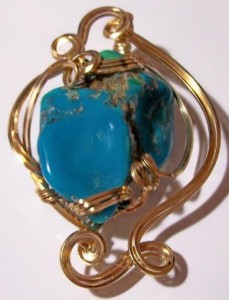
Frances Lediaev wrapped this turquoise nugget in wire, making sure the bail was wide enough for her client’s large Omega chain
Rainbow Calsilica
Another type of man-made stone is Rainbow Calsilica, a really cool and beautiful stone often associated with turquoise, not to be confused with chrysocolla, which is a natural stone often mistaken for turquoise. I even purchased some a few years back called "Turkey Turquoise," that was purple rainbow calsilica. It’s beautiful and great to use in my jewelry, but it is a man-made stone. There is quite a controversy about rainbow calsilica, but the general consensus from scientists is that it is a beautiful stone is made from powdered carbonate rock that has been colored and stabilized with polymers. Although it is in high demand and often paired with other more expensive stones, just be aware that it is man-made.
Artificial Turquoise and Imitation Turquoise
Artificial and imitation turquoise is generally either turquoise colored plastic or dyed howlite or other stone made to look like actual turquoise. Generally, if it looks like plastic, it probably is. Dyed howlite is another story and another "buyer beware" moment. If you’re wondering whether the stone is truly artificial or reconstituted, you can do the hot pin test. If the smoke is acrid, like a plastic smell, the turquoise is probably not genuine. However, if a stone is stabilized, it could still give off that acrid smell depending on the stabilization material used.
White Buffalo Turquoise
White Buffalo turquoise, not to be confused with "white turquoise" that is actually howlite, is a very rare colorless turquoise and is missing only copper in its chemical formula. Some unscrupulous dealers have been trying to pass off howlite as Sacred Buffalo Turquoise, also known as Dry Creek Turquoise. However, this rare turquoise has only been found in the Dry Creek Mine on the Shoshone Indian Reservation in Nevada, and has likely been played out. It would be very rare to find genuine sacred buffalo turquoise. Again, knowing your dealer really helps in this situation, and having a little education goes a long way.
So, in the world of turquoise, there are many varieties and nuances. From enhancements that keep color from fading to funky colors that don’t even remind us of turquoise, this color/stone/gem is a fascinating part of our lives and culture throughout the ages. Who can resist turquoise jewelry?
Next time, we’ll talk about Garnet, the beautiful birthstone of January. Have you made wire jewelry with garnet before? Send in pictures and they could be featured! Send your garnet pictures to tips@wire-sculpture.com. See you next week on Wednesday – and Happy New Year!
Resources & Recommended Reading
- Turquoise on Wikipedia
- Turquoise Guide
- Turquoise used in American Indian Jewelry
- Gemcutters.org
- Calsilica is it Natural?
- Calsilica the Controversial Gemstone
- Lapidary Newsletter (PDF Download)
- Sacred Buffalo White Turquoise, What is it?
- MinDat – Rainbow Calsilica
- MinDat – Turquoise Problems
Gem Profile by Layna Palmer
Click to Receive Daily Tips by Email





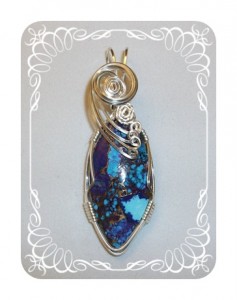
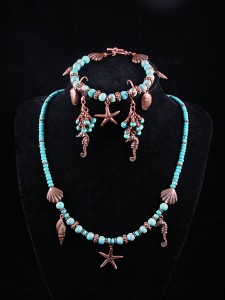


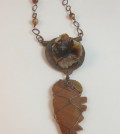




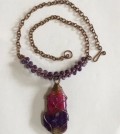


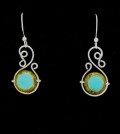




Carol Praissman
December 28, 2012 at 7:17 am
Thank you so much for the lowdown on Turquoise. I’ve been buying all kinds of beads for over 45 years now. At this point I’m going to get my turquoise trays out & see if some of my torquoise isn’t something else. The dealer I bought from with great trust died 8 years ago. What have I gotten since then?
AnnaMariah
December 29, 2012 at 4:54 pm
Thanks for the info on Mohave Turquoise, I discovered it couple of years ago called copped turquoise. The purple copper turquoise can be especially stunning as well as the off white – where the gold/copper veining really is quite beautiful.
I prefer to buy my turquoise at gem shows – as a gemstone empath, I am looking for looks but also an energetic quality which surprisingly is sometimes still quite good in some of the lower grades and even various versions of stabilized, fake, etc…and other times I’ll pick up something and it is just horrible to hold. It’s sometimes surprising how good or bad a particular strand or stone can be. I’ve been using a lot less turquoise in the last few years due to the inconsistency of what I’ve been finding.